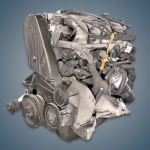The 2.8-liter Audi AAH 2.8 V6 gasoline engine was produced by the concern from 1990 to 1997 and was installed on the most popular models of the German company such as 80, 100, A4, A6 or A8. This power unit was known in some markets under a completely different AFC index.
The EA835 series includes: ABC, AAH, ALF, BDV, ARE, ACK, ALG, BBJ, ASN.
Specifications
| Production years | 1990-1997 |
| Displacement, cc | 2771 |
| Fuel system | injector |
| Power output, hp | 174 |
| Torque output, Nm | 245 |
| Cylinder block | cast iron V6 |
| Block head | aluminum 12v |
| Cylinder bore, mm | 82.5 |
| Piston stroke, mm | 86.4 |
| Compression ratio | 10.3 |
| Features | no |
| Hydraulic lifters | yes |
| Timing drive | belt |
| Phase regulator | no |
| Turbocharging | no |
| Recommended engine oil | 5W-30 |
| Engine oil capacity, liter | 5.0 |
| Fuel type | petrol |
| Euro standards | EURO 2 |
| Fuel consumption, L/100 km (for Audi 100 1993) — city — highway — combined |
12.9 7.4 9.0 |
| Engine lifespan, km | ~350 000 |
The engine was installed on:
- Audi 80 B4 (8C) in 1991 – 1995;
- Audi 100 C4 (4A) in 1990 – 1994;
- Audi A4 B5 (8D) in 1994 – 1997;
- Audi A6 C4 (4A) in 1994 – 1997;
- Audi A8 D2 (4D) in 1994 – 1996.
Disadvantages of the Audi AAH engine
- The main complaints of car owners with such an engine are related to oil consumption.
- Oil consumption due to the occurrence of rings begins after 150,000 km and increases with mileage.
- Also, grease likes to ooze from gaskets and seals, especially after overheating.
- The timing belt is designed for about 90 thousand km, and when it breaks, the valves always bend.
- Floating revolutions are usually caused by contamination of the idle control valve.






